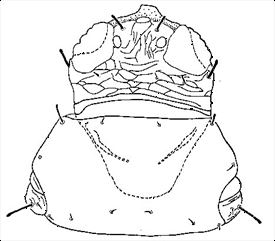Distinguishing features
Female rarely fully winged, usually apterous. Pale yellow, with brown markings on tibiae and tarsi; distal half of antennal segment III and all of segments IV–VIII pale brown; fore wings (when present) shaded. Head wider than long, dorsal surface sculptured, bearing 2 pairs of small setae; cheeks rounded, slightly constricted at base; ocelli present; ocellar setae short, slightly expanded at apex; cheek margins with a pair of short setae lying behind eyes, these slightly expanded at apex; maxillary stylets very short, restricted to mouth cone. Antennal segment II with dorsal setae stout, truncate; III with long pedicel and a small basal ring; VII slender, closely joined to VIII; segment III with 1 sense cone, IV with 2 sense cones. Pronotum with anteroangular and epimeral setae slightly expanded at apex; no long posteroangular setae; basantra present. Mesopresternum transverse, entire. Metanotum with no sculpture medially; metathoracic sternopleural sutures very small. Fore tarsal tooth absent. Fore wings with 1 pair of very small, peg-like sub-basal setae. Pelta weakly sculptured, lateral lobes reaching almost to tergite II lateral margins; tergites II–VII each with 1 pair of wing-retaining setae; tergite IX posteromarginal setae S2 longer than S1 or S3, S1 pointed. S2 blunt; tube longer than head, anal setae short; sternites with about 10 discal setae. Female aptera similar but paler, ocelli and ocellar setae absent; metanotum broad, reticulate, with scattered discal setae; pelta oval, close to tergite II.
Male similar to female aptera, tergite IX setae S3 longer than S1 or S2; no tubercle venrally between eyes; no tubercle on posterior margin of tergite IX.
Related species
The genus Sophiothrips comprises 31 species worldwide. Five of these are endemic to Australia, with one of these five also in New Zealand. Three further species constitute the duvali-group from New Zeland and Norfolk Island, in which antennal segment III bears 2 sense cones instead of just a single sense cone as in S. greensladei and the other Sophiothrips species. S. greensladei is also unusual in lacking a fore tarsal tooth in females.
Biological data
Usually collected in leaf litter but also from dead branches; presumably feeding on fungal hyphae.
Distribution data
Described from, and widespread in, eastern Australia, this species has also been taken at several sites in New Zealand (AK, CL, WN).
Family name
PHLAEOTHRIPIDAE, PHLAEOTHRIPINAE
Species name
Sophiothrips greensladei Mound & Walker
Original name and synonyms
Sophiothrips greensladei Mound & Walker, 1982: 352
References
Mound LA &Tree DJ (2014) The minute, fungus-feeding species of Sophiothrips (Thysanoptera, Phlaeothripinae) from Australia and New Zealand. Zootaxa 3860 (2): 184–194.
Mound LA & Walker AK (1986) Tubulifera (Insecta: Thysanoptera). Fauna of New Zealand 10: 1–140.


